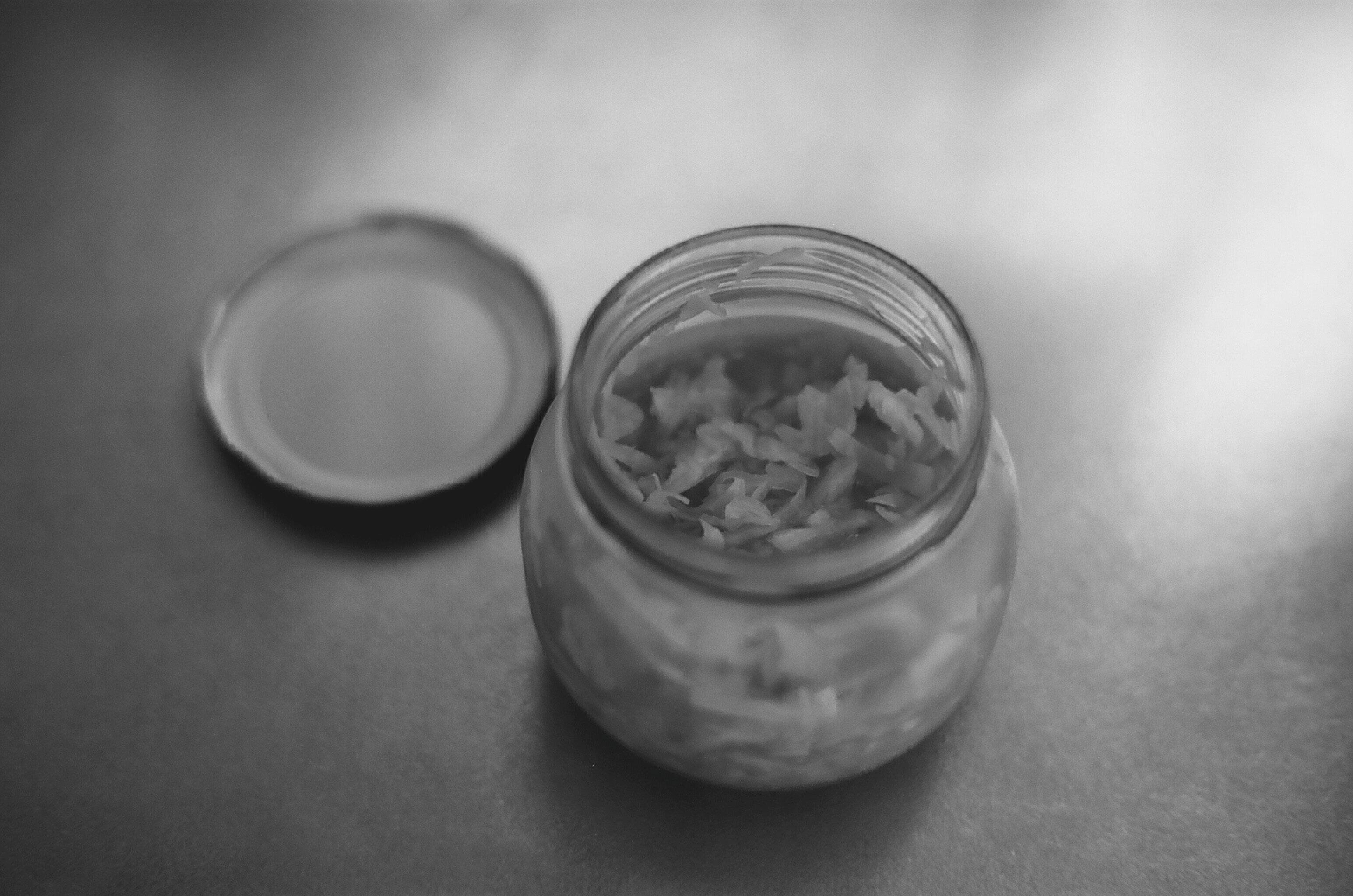[化学論文のための英語講座] 第81回:ミニコーナー ザワークラウト Mini Corner Sauerkraut
2025年7月22日

(English version is here.)

読者の皆さんはすでにご存知のように、料理においては化学が重要な役割を果たしています。揮発性、混和性、粘度、酸、塩基、乳化などが、しばしば重要となります。発酵により保存性や栄養価が向上する場合が多くあります。微生物も登場します。酵母なくしてお酒はなく、納豆菌なくして納豆はなく、乳酸菌なくして漬物はないでしょう。
自家製発酵野菜は手間がかかると思っていませんか。実は基本的なザワークラウトの作り方はとても簡単です。ザワークラウトとは、キャベツを塩で漬け込み、発酵させたドイツの伝統的な発酵食品です。ガラス瓶、まな板、包丁さえあれば作れます。素材はキャベツと食塩です。そうです。キャベツと塩だけです。もちろん、好みで他の野菜や調味料も入れてもよいですが、基本的にはキャベツと塩だけで十分です。料理法は以下のとおりです。
ザワークラウトの作り方 材料
| キャベツ | (約)600グラム |
| 食塩 | (約)15グラム |
| 水 | 適量 |
(同比率で増量も可能!)
1. キャベツを細切りにする。
2. 食塩を加え、よく混ぜる。キャベツの水分が出てくるまで混ぜる。
3. キャベツ(出てきた水分ごと)を瓶に詰める。キャベツが完全に浸かるくらいの水を加える。出てくる水分がかなり多く、キャベツが浸かっている場合は、水を加える必要はありません。
4. 瓶を緩く閉める。
5. 室温※にて冷暗所で2~4週間放置する。
※16~20℃。日本では、夏場は半日~1日で発酵することもあるのでお好みで調整してください。夏に室温で長時間置いておくと腐敗してしまう可能性もあるので注意してください。
基本的には、そのまま置いておいて良いのですが、初期に二酸化炭素が発生する(ポコポコする)時は、キャベツを浸けるために1日1回キャベツを押し下げます。微生物の種類は最初の段階では多様ですが、酸性が高まると乳酸菌が優勢に(酸っぱく)なります。発酵が終わってから冷蔵庫で数ヶ月保存できます。
自家製ザワークラウトを自分で作ってみませんか。
次回もどうぞお楽しみに。
 As our readers already know, chemistry plays a vital role in cooking. Volatility, miscibility, viscosity, acidity, basicity, emulsification and so on are often important. Fermentation often improves preservative and nutritional value. Microorganisms also play a role. There would be no wine without yeast, no natto without natto bacteria, and no pickles without lactobacillus.
As our readers already know, chemistry plays a vital role in cooking. Volatility, miscibility, viscosity, acidity, basicity, emulsification and so on are often important. Fermentation often improves preservative and nutritional value. Microorganisms also play a role. There would be no wine without yeast, no natto without natto bacteria, and no pickles without lactobacillus.
Is preparing homemade fermented vegetables a lot of work? Actually, making basic sauerkraut is very easy. Sauerkraut is a traditional German food made by pickling and fermenting cabbage with salt. If you have a glass jar, a cutting board and a sharp knife, you can prepare it. The ingredients are cabbage and table salt. That is correct, just cabbage and salt. Of course, one can add other vegetables or seasonings to taste, but basically cabbage and salt are enough. Preparation is as follows:
Sauerkraut Ingredients
| Cabbage | 600 grams (about) |
| Salt | 15 grams (about) |
| Water | as needed |
(The recipe can be increased proportionally!)
1. Finely chop the cabbage.
2. Add the salt and mix well. Continue mixing until liquid is drawn out of the cabbage.
3. Pack the cabbage (along with the liquid) into a glass jar (or jars). Add sufficient water to completely cover the cabbage. If there is sufficient liquid to cover the cabbage, additional water is unnecessary.
4. Loosely close the jar(s).
5. Store in a cool, dark place for 2~4 weeks.
note: A temperature of 16~20 °C is ideal. In Japan, fermentation can take anywhere from a half day to a day in summer, so adjust the time to suit your taste. Keep in mind that if you leave it at summer room temperature for long, it may spoil.
Basically, it can be left as is, but at the early stages of fermentation when carbon dioxide is being produced (bubbling), the cabbage can be pressed once a day to ensure that it remains submerged. The microorganisms are diverse initially, but as the acidity increases, lactic acid bacteria become dominant (sour). After fermentation is complete, the sauerkraut can be kept under refrigeration for several months.
Would you like to try making your own home-made sauerkraut?
We look forward to seeing you next time.